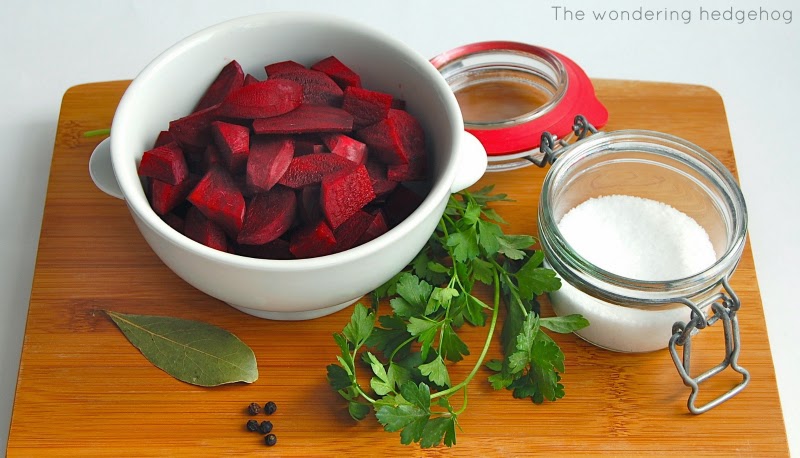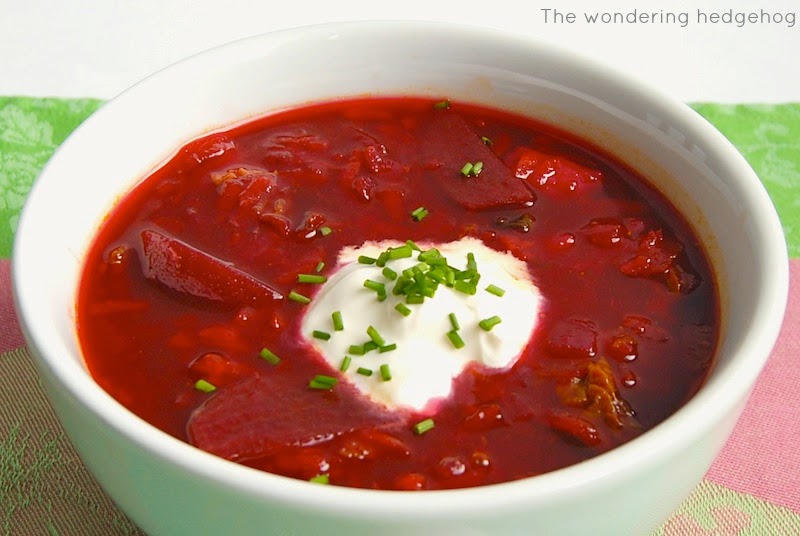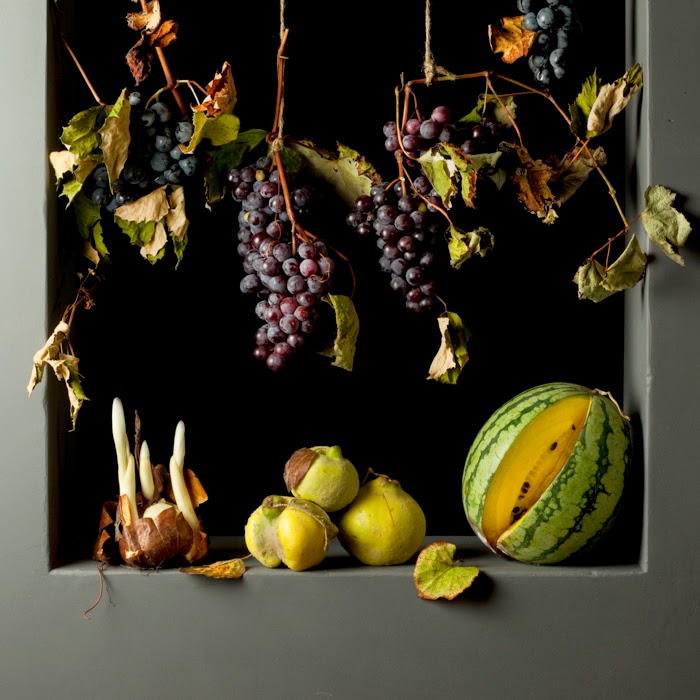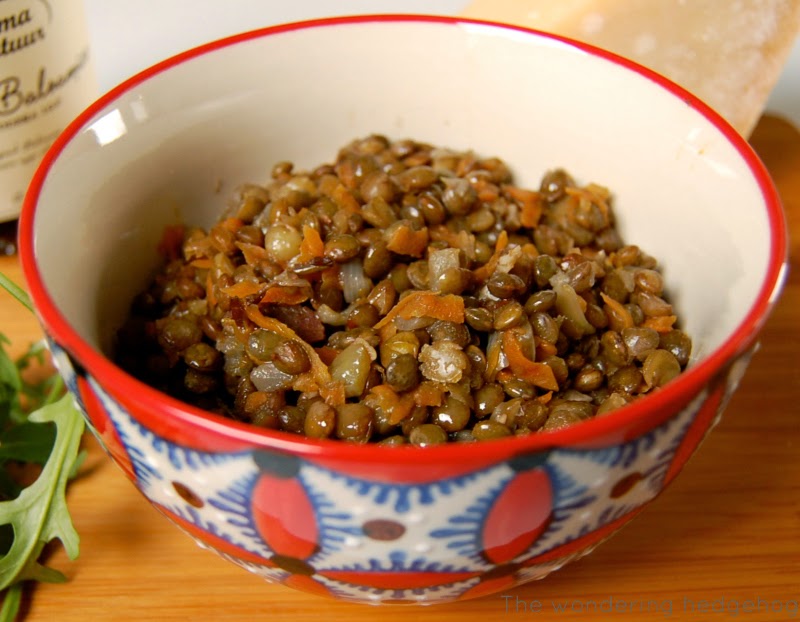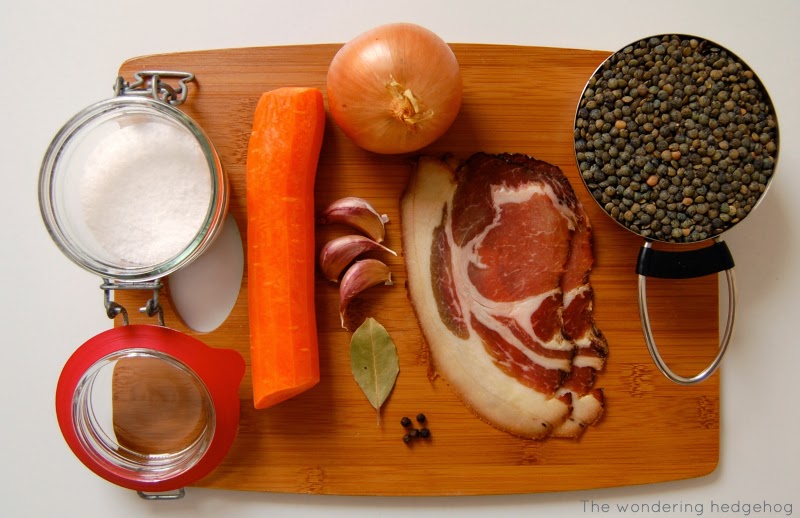~ Robert A. Heinlein, Time Enough for Love
mise en place
/miz ɑ̃ plas/
noun
|
Borsch is a hymn to the glory of beets. And beets are glorious. Anyone who judges beets based solely on a single out-of-the-can experience is perpetrating a great injustice, both against the beets and against their own person. An incredibly versatile vegetable, beets can be eaten in raw, roasted, boiled, and even liquid (ginger-apple-beet juice!) form. Beets, both roots and greens, are high in antioxidants and vitamins. More importantly, properly cooked beets are very, very tasty.
I grew up eating beets, and they are one of my favorite vegetables, for the emotional comfort as much as for their flavor. And when beet nostalgia melds with the intrinsic comfort of soup, the result will help weather any winter. Enter borshch/borsch/borscht1, the traditional Eastern European beet soup.
This is my interpretation of my grandmother's vegetarian recipe, a lighter version of the beef-based borsch. The big departure from the original is the replacement of the traditional cabbage with bitter lettuce, an idea gratefully borrowed from Chinese cooking. Beets, carrots and tomato paste are all quite sweet to my palate, and the neutral flavors of potatoes and cabbage do not offset this sweetness. Lettuce provides the necessary contrast, and makes the soup less heavy, though no less hearty. Using lettuce has the added benefit of not having to shred cabbage.
Although the preparation process is simple and does not take a lot of time, it does require that undivided attention is paid for five minutes. Nothing ruins a dish so fast as burning the onions. The classical French cooking practice of mise en place, while seemingly more time-consuming, actually makes the entire process more efficient. Roughly translated, mise en place means "putting in place", or having everything ready before cooking actually starts. As tempting as it is to grate the carrots while the onions are browning, or peel and chop the potatoes while the tomato paste is cooking down, this is usually a false economy - it is best to get everything ready before you begin. There are culinary benefits as well - preparing the potatoes ahead of time removes some of the starch; giving the lettuce a cool bath revives wilting leaves.
Borsch 2.0
The recipe invites experimentation - use more or less of any vegetable as you prefer. Potatoes can be replaced with celery root, parsnips or both. And of course, lettuce can be swapped for green cabbage. Shred the cabbage and add to the soup together with the carrot mixture.
Serves 4-6
- 2-3 medium / 5-6 small beets
- 1 large carrot
- 1 medium onion
- 2 medium potatoes
- 1-2 heads bitter lettuce, such as Little Gem or Romaine
- 2-3 cloves of garlic
- 2-3 Tablespoons tomato paste
- 1 bay leaf
- 5-7 peppercorns
- 3-5 sprigs fresh parsley or thyme
- Salt
- 1-2 Tablespoons oil (olive, rice bran, canola, grapeseed)
Peel and rinse the root vegetables. Chop the onions, grate the carrot on the large holes of the grater and lightly crush the garlic cloves.
If feeling lazy, grate the beets. If feeling fancy, cut the beets into nice wedges. For small beets, simply cut in half and then each half into wedges (for larger beets, first slice each half into thirds).
Wash the lettuce and remove outer leaves if they are yellow or bruised. Quarter the lettuce and chop each quarter into bite-sized pieces; put in the refrigerator or a bowl of cold water.
Cut the potatoes into cubes or medium chunks. Place cut potatoes in a bowl of cool water to prevent browning from oxidation.
Bring 4 Cups of water to a boil in a large pot. Add 2 teaspoons salt, peppercorns, parsley/thyme and beets. Lower heat to a simmer.
Heat the oil in a (non-stick) pan over medium heat. Add onions and a pinch of salt. Cook, stirring occasionally, until the onions become translucent and start browning around the edges.
Push the onions to the perimeter of the pan, and add the tomato paste. Cook the paste in the center until it becomes fragrant, a minute or so. Frying the paste in oil helps remove the tinned flavor. Stir the onions into the paste. Cook, stirring to prevent burning, for another 3 minutes, until the mixture thickens.
Add the carrots and garlic cloves, a generous pinch of salt and mix to combine. If stirring is difficult because the onion mixture is too thick, add ¼ Cup of cooking liquid from the beets. Lower the heat and cook the carrots, stirring occasionally, for another 5 minutes.
Add the carrot-onion-paste mixture to the beets. Continue to simmer for another 25 minutes for beet wedges, or 20 minutes for grated beets.
Taste the broth for salt, and add more if necessary. Add the drained potatoes to the pot (if the soup has thickened too much, add some boiling water so the potatoes are submerged). Cook until the beets and potatoes are just tender. Start testing after 20 minutes; cooking time will depend on the size of vegetables.
Once the beets are tender, stir in the drained lettuce and increase the heat. When the soup comes back to simmer, cover the pot and turn off the heat, but leave the pot on the stove. The lettuce will wilt and mellow from the residual heat without falling apart. Borsch is always better after a day or two in the refrigerator. If you are feeling impatient, let the pot rest for 15-20 minutes before eating.
Beets like acid; if desired, round out the borsch with just a splash of balsamic or white vinegar.
Serve the borsch hot with a dollop of crème fraîche or sour cream, and some chopped dill. For a really traditional accompaniment, cut a clove of raw garlic in half and rub the cut side on the crust of some heavy dark bread. The optional vodka shot must be served straight from the freezer and have the consistency of syrup.
1 As the Russian spelling does not contain a t and English speakers are not informed that it is silent in the transliteration, this has become quite a pet peeve. There is no t in borsch!




